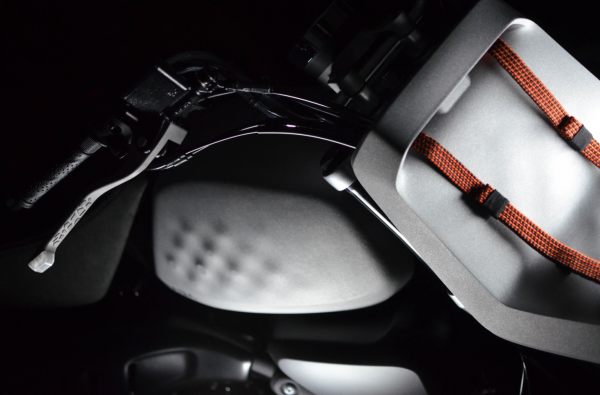
The classic Honda Monkey bike. First built in the 1970s and loved by all. As of late, it’s had somewhat of a resurgence, and the now modernised mini machine is just as popular as it was back in the ’70s. However, French motorcycle maker VIBA wanted to rethink the Monkey, by using modern craftsmanship, design, and manufacturing processes - in this case, aluminium 3D printing.
VIBA teamed up with rapid manufacturing specialist SLM Solutions and the final result is certainly interesting…
The VIBA Monkey called is Jane, named after Jane Fonda, and it features a revolutionary 3D printed aluminium fuel tank, gauge bracket, hollow brake and clutch levers, front luggage rack, mudguard and headlight support. The redesigned bike harkens back to the retro but is completely modern in both looks and manufacture.
Granted, it does look a little bit odd, especially with those luggage straps. It’s like two worlds have collided and a mutant love child was born out of the molten smelt, having a face only a mother could love. However, let’s take a step back and think about how the parts of this machine were made using aluminium 3D printing. Such a technique is extremely futuristic and opens up a whole new world of opportunities.
For example, the 3D printed fuel tank isn’t hollow. Strange, but hear me out. The whole tank only weighs 3.3 kg, and integrates an internal honeycomb structure that stops fuel from sloshing around as the motorbike is operated. On the road, such an innovation isn’t going to set the world on fire, but for racing, this could drastically increase the stability of the bike on the brakes and coming off/on the power - making the bike more predictable and thus, slashing lap times.
How was the VIBA Honda Monkey made?
In layman's terms, the VIBA Monkey's parts were constructed using additive manufacturing where “structures are made by the addition of thousands of minuscule layers which combine to create the product. The process involves the use of a computer and special CAD software which can relay messages to the printer so it “prints” in the desired shape”
The benefits of this method of manufacture are reduced construction time and reduced cost, as full-size prototypes can be rapidly made and tested. In terms of design, it offers more freedom, and because of this, many custom motorcycle makers are starting to use additive manufacturing.
Plus, if any owners of the VIBA Monkey have a little spill on their futuristic machine, then parts can be quickly reprinted and shipped out el rapido. Pretty neat aye?
What do you think of the VIBA Honda Monkey? Dope or nope?
Let us know in the comments below.

